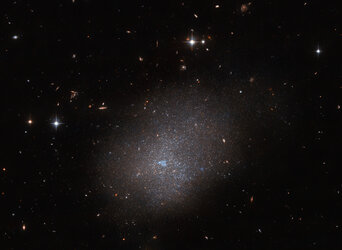

Portrait of a ghostly galactic peacock
The lenticular galaxy NGC 6684 bathes this image from the NASA/ESA Hubble Space Telescope in a pale light. Captured with Hubble’s Advanced Camera for Surveys, this lenticular galaxy is around 44 million light-years from Earth in the constellation Pavo. Pavo — whose name is Latin for peacock — is a constellation in the southern sky and one of four constellations collectively known as the Southern Birds.
Lenticular galaxies like NGC 6684 (lenticular means lens-shaped) possess a large disc but lack the prominent spiral arms of galaxies like the Andromeda Galaxy. This leaves them somewhere between elliptical galaxies and spiral galaxies, and lends these galaxies a diffuse, ghostly experience. NGC 6684 also lacks the dark dust lanes that thread through other galaxies, adding to its spectral, insubstantial appearance.
The data in this image were captured during a census of the nearby Universe entitled Every Known Nearby Galaxy which aims to observe all galaxies within 10 megaparsecs (32.6 million light-years) that the telescope has not already visited. Before this programme began Hubble had observed roughly 75% of these nearby galaxies, and completing this census will reveal insights into the stars making up a wide variety of galaxies, in a wide variety of environments.
[Image Description: A galaxy, large and occupying most of the view from the centre. The whole galaxy is made of smooth, diffuse light. The galaxy is surrounded by a smoky grey halo. Many stars shine around the galaxy, on a black background.]





